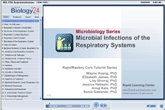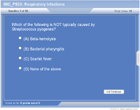| How to Learn in 24 Hours? |
|
| Need Help? |
M-F: 9am-5pm(PST):
Toll-Free: (877) RAPID-10
or 1-877-727-4310
24/7 Online Technical Support:
The Rapid Support Center
vip@rapidlearningcenter.com
Secure Online Order:

|
| Tell-A-Friend: |
Have friends taking science and math courses too? Tell them about our rapid learning system.
|
|
Respiratory System Infections
| Topic Review on "Title": |
- The structures of the upper respiratory system: pharynx, middle ears, sinuses, nasal cavity, auditory tube opening.
- Function of the upper respiratory system is to collect and filter air. Including filtering of: pollens, microbes and other contaminants in the air.
- Structures of the lower respiratory system include: larynx, trachea, pleura, bronchus, bronchiole.
- Auditory (eustachian tubes) from the ears to the pharynx allow air pressure to equalize.
- Tonsils or adenoids are aggregations of lymphoid tissues and located near the junction of the nasal cavity and pharynx. Tonsils have cells and chemicals to fight microbes.
- The lower respiratory system does not normally have microorganism and is referred to as axenic. The cilia, secretary antibodies and phagocytic cells keep the organs clear of contaminants.
- The upper regions of the pharynx is home to several organisms including: some relatively harmless Gram negative cocci, diphtheroids, opportunistic Staphylococcus and alpha-hemolytic streptococci including Streptococcus pneumoniae. The latter is an opportunistic pathogen and causes most cases of pneumonia. The organisms that live in the pharynx can lead to an infection of the middle ears and sinuses.
- Bacterial diseases of the upper respiratory system, sinuses and ears can be caused by bacteria.
- Pneumonia is an inflammation of the lungs the alveoli and bronchioles may become fluid filled.
- Empyema the name of the condition if the fluid filling a lung is pus.
- The most common infection of the upper respiratory system is commonly called “the common cold”. However the common cold is not caused by a single virus but as many as 900 viruses can cause a cold.
- Flue virus structure and evolution
- Antigenic drift and antigenic shift
- Fungal infections.
|
| Rapid Study Kit for "Title": |
| Flash Movie |
Flash Game |
Flash Card |
| Core Concept Tutorial |
Problem Solving Drill |
Review Cheat Sheet |
 |
 |
 |
|
| "Title" Tutorial Summary : |
The respiratory system is essential for well being. It is frequently being assailed as an entry point for pathogens. Mechanisms for keeping pathogens out and removing those that have managed to enter have evolved to protect the body as well as the respiratory system.
Likewise pathogens exploit many of these mechanism to evade their own expulsion or killing. The main components and structures of the respiratory system and the mechanisms that these systems use to prevent or reduce the impact of pathogens are presented. The methods that a representative group of pathogens use to exploit entry into the respiratory system are also profiled.
|
| Tutorial Features: |
Specific Tutorial Features:
- The structure of the respiratory system.
- Characteristics of an upper respiratory infections.
- Characteristics of an lower respiratory infection.
- Pathogenic bacteria, viruses and fungi in the respiratory system.
- Animations of pathogen Life Cycles
Series Features:
- Concept map showing inter-connections of new concepts in this tutorial and those previously introduced.
- Definition slides introduce terms as they are needed.
- Visual representation of concepts
- Animated examples—of concepts are used to step wise breakdown a concepts.
- A concise summary is given at the conclusion of the tutorial.
|
| "Title" Topic List: |
Bacteria, viruses and fungus can all cause respiratory infections.
The upper respiratory system has naturally occurring bacteria that do not cause disease.
The lower respiratory system does not typically have microbes.
Flu virus evolution: antigenic shift and antigenic drift.
Bacterial, Viral and Fungal infections in the upper and lower respiratory systems are diagramed.
|
See all 24 lessons in Anatomy and Physiology, including concept tutorials, problem drills and cheat sheets:
Teach Yourself Microbiology Visually in 24 Hours
|



